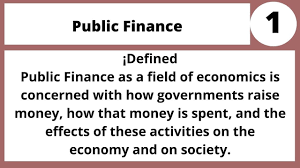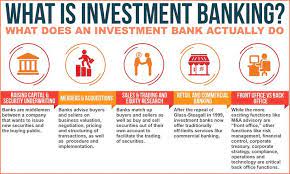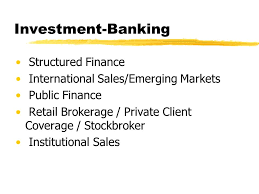
One of the less well-known divisions of investment banking is public finance investment banking. It definitely isn’t in the focus for most candidates because it primarily deals with the public sector and the government.
Governments seeking underwriters for their bonds, government-owned businesses, non-profit organizations, and educational institutions seeking counsel on how to fund their debt and projects are among the clients of public finance investment banks.
What is Public Finance?

Globally, there are severe financial systemic failures and budgetary imbalances. There is a lot of demand on public financial institutions, including finance ministries, tax and customs authorities, central banks, public lenders, and public pension funds, to modernize, boost transparency, and improve their operations in order to deliver better results for citizens.
Why Public Finance:
Although it is always important, the current political and economic context makes it much more so. Finance professionals can have a lasting and significant impact on local communities on a local, national, and international level by working in the public sector.
Public finance banking, which deals with taxation and spending of various civic groups, is essential for the prosperity of a country. It is essential for an economy to get the financial resources required to accomplish social wellbeing.
High degrees of creativity are required to work in public finance, finding creative ways to use scarce resources to best serve communities. Anyway, this sector is bright for Public Finance careers.
Public Finance vs Private Finance:
Public finance is the study of a state’s or a government’s revenue and expenditure activities. Private finance examines the income, expenses, and business dealings of private people and private companies.
Components of Public Finance:
The key activities that make up public finance are those involved in revenue collection, societal support expenditures, and the implementation of a financial strategy (such as issuing government debt).
The following are the important parts:
Tax collection: The primary source of income for governments is tax collection.
The budget is a blueprint of the expenses the government expects to incur within a fiscal year.
Expenditure: Everything that a government actually spends money on, such as social services and education, is referred to as an expenditure.
Deficit/Surplus: A deficit occurs in a year when the government spends more than it brings in.
National Debt: If the government has a deficit, it will borrow money and issue national debt to make up the shortfall.
Public Finance Revenue and Expenditures:
A list of some of the most typical public finance revenues and expenses may be seen below.
Revenue / Taxes
- Income tax (personal, corporate)
- Property tax
- Sales tax
- Value-added tax (VAT)
- Import duties
- Estate tax
Expenses
- Health care
- Employment insurance
- Pensions
- Education
- Defense (military)
- Infrastructure
Introduction to Public Finance Investment Banking:

Public finance investment banking is one of the more contentious business sectors. Compared to other industry groups and product groups, it is a more specialized group with some drawbacks (e.g., more limited exit opportunities).
But if that’s the justification for saying it’s “not banking,” you might as well say that ECM and DCM aren’t banking too.
Public Finance Investment Banking Definition: It highlights a sector within the investment banking division. Its emphasis is on the public sector, which includes state and municipal governments, publicly-traded businesses, as well as nonprofit and educational organizations
Underwriting municipal securities, such as the debt that governments issue to finance the construction of infrastructures like bridges, trains, and airports.
One aspect of public finance is the underwriting of municipal bonds, but there are others as well.
- Goldman Sachs – Includes Public Sector & Infrastructure
- Morgan Stanley – Public finance is included in fixed income
- Jefferies – Public finance is included in investment banking and fixed income at Jefferies.
What does public finance investment banking serve?
State and local governments that borrow money on the municipal bond market would be the clients of an investment banker who specializes in public finance. Consider a straightforward scenario where a state decides to construct a large bridge over a river, issues bonds to finance the project, charges a toll to cross the bridge, and uses the proceeds of the tolls to pay off the bonds’ principal and interest over the course of several years.
Difference between Public Finance and Project Finance and Debt Capital Markets (DCM):
In contrast to for-profit enterprises, common clients tend to be governments, non-profit organizations, and other tax-exempt bodies.
Project Finance – The primary distinction is the clientele, and this branch of finance also tends to involve more precise, cash-flow-level modeling.
Debt Capital Markets (DCM) – Since DCM may also provide government clients with investment-grade bond issuance advice, there is some overlap here.
Leveraged Finance – LevFin frequently counsels for-profit businesses on the debt needed to fund operations like leveraged buyouts and mergers.
Infrastructure, healthcare, and power & utilities – There is considerable overlap between these groups, but in each case, you will primarily be counseling for-profit businesses.
What Do You Do in Public Finance Investment Banking as an Analyst or Associate?

You will begin your career in public finance investment banking as an analyst. You are promoted to associate after two or three years. You can advance to the vice president position after another two to three years. You might be able to advance to the director or managing director level there if you perform well.
With an average yearly compensation of $78,353, the anticipated total pay for a Public Finance Investment Banking Analyst in the United States is $95,325.
In the field of public finance, bankers size and arrange municipal bond issuances using the industry-standard DBC tool, which can also calculate debt service ratios and assess refinancing scenarios.
The program generates the reports and other important outputs after you input the necessary data.
However, DBC by itself is insufficient for everything, much like ARGUS in real estate.
This DBC program helps you save time and makes it simpler to perform simulations and scenarios, but it isn’t a foolproof fix for all problems.
An Analyst’s or Associate’s typical day will include the following activities:
Reviewing Bond Documents: You devote a lot of effort to studying the terms and structuring of an issuer’s existing bonds.
Making Presentations for Customers and Future Customers: Additionally, you’ll create fresh proposals and monthly updates for existing and potential businesses.
Responding to Requests for Proposals (RFPs): In bidding situations, issuers will send multiple banks RFPs in an effort to compare contract conditions and costs and obtain the best pricing.
Modeling Different Transaction Forms: You almost usually provide various deal structures in bids, pitches, and RFP responses.
Public Finance Salaries and Bonuses:

Public finance investment banking has historically paid considerably less than other sectors for a number of reasons:
- Lower Fees
- Top-Heavy Deal Flow
- Public Perception
- Bundling of Other Services
The combined compensation as a result of these factors is typically 20–30% less.
Typically, this means that base salaries are about equivalent, with significantly smaller bonuses (e.g., 50 percent of base salary rather than 100 percent ).
But this varies by company and by market, and smaller companies might even offer lower bonuses.
Also, pay notice of the fact that public finance teams frequently take a while to increase base pay to match other IB groups.
Exit opportunities in public finance investment banking:
The good news is that because public finance is intertwined with so many other functions within a large bank, such as traditional investment banking, sales & trading, direct lending, derivatives, project financing, and more, it’s rather simple to move about within one.
Additionally, if your industry includes regular IB-style assignments, like healthcare, you could transition into corporate finance or corporate development position with a for-profit healthcare organization.
The bad news is that exits from typical hedge funds and private equity firms are not very common.
Public Finance Investment Banking: Pros and Cons:
For professional bankers looking for a nice work/life balance, work that’s somewhat fascinating, and remuneration that’s high but not top-tier, public finance is fantastic.
It’s not as great if you’re new to the field and unsure of your long-term objectives. There are some pros and cons for Public Finance Investment Banking.
Pros:
You’ll work fewer hours than in the majority of other IB industry and product areas, which will improve your lifestyle (but still far more than a 9-to-5 job).
- Stability
- Possibility of a Specialized Modeling Background and
- TalentInternal Mobility
- It’s Very Nice at the Top
Cons:
You might spend a lot of time responding to RFPs and carrying out other data-gathering chores for smaller companies.
- The Work Can Be Tedious / Boring
- Compensation is Significantly Lower
- Exit Opportunities Are Limited
- If you stay too long, you’ll be put inside a box.
FAQ – Public Finance Investment Banking:
Why do Public finance bankers underwrite government/municipal bonds?
Investment banks support local governments by assisting with the underwriting of debt needed to construct new roads, bridges, airports, and other public assets or to restructure existing debt. Due to their size and standing, bulge bracket banks occasionally serve as underwriters for treasury (government) bonds. Local (municipal) bonds issued by local governments are primarily underwritten by smaller boutique banks.
What are the Exit Opportunities for Public Finance Investment Banking?
Due to the group’s strong specialization, there aren’t many departure chances in public finance investment banking. The most sensible options include hedge funds, the public sector, governmental organizations, or other investment banking industry associations.
Given your extensive experience with bonds in public finance, another option, if you wish to pursue investment banking, is in the debt capital market.
How Can I Enter Investment Banking for Public Finance?
About Public Finance Investment Banking, it takes time and effort to break into the investment banking industry. After the screening process, you must network and do anything from modifying your resume to getting appropriate finance experience. Perhaps though it may take you months or even years to prepare, anything is achievable with perseverance and hard effort.
Step 1: Procure experience in the field of finance
You should emphasize any relevant experience you have through internships at fixed-income funds or in investment banking. Participating in banking student societies and taking courses relating to public finance is also beneficial in Public Finance Investment Banking.
Step 2: Create a resume for investment banking:
Discover what the bank is looking for and demonstrate that you have the qualities of an investment banker. Typically, your CV should demonstrate your:
- Outstanding academic credentials
- Characteristics of investment bankers
- Financial inclination
Step 3: Network to get beyond the selection process:
In order to get your CV past the initial screening stage, networking is one of the most crucial activities. Although they can be effective, cold calling and cold emailing should only be used as a last resort.
To make a link, try to start by concentrating on the alumni of your school. Email them to learn more about the hiring process or to set up informative interviews after finding them on LinkedIn and in your school’s database.
To keep up with recruitment, you might even need to determine in your first year whether or not you want to pursue a career in banking.
Step 4: Finish the interviewing procedure
Before receiving an offer, you must go through two rounds of interviews: HireVue and Superday.
The “fit” questions on HireVue, such as why public finance investment banking, why us, your strengths and limitations, etc., will be the main focus.
The Superday is the last interview round, and it’s where your technical prowess and mental fortitude are put to the ultimate test.
Public finance Career Paths Example for students:
Here are a few examples in Public Finance Investment Banking
: Administration: Office Manager, Executive Assistant, and Administrative Assistant. Advertising: Account Executive, Senior Account Executive, Assistant Account Executive, and Account Executive.
Career Planning in Banking:
To succeed in your chosen career, you must plan your career. If your current position is preventing you from attaining your career goals or if you are not content with it, it may be time for a change. The banking and financial sector has a healthy number of jobs, and there are prospects for career advancement.
Investment bankers who specialize in public finance deal with a broad range of public sector, nonprofit, and developer customers.
Financial analysts, investment bankers, public accountants, risk managers, corporate controllers, and investor relations officers are popular job paths in the corporate finance industry.
Personal finance, corporate finance, and public finance are the three divisions that make up the field of finance.
You should consider a career in finance if you are driven by the difficulties of a demanding job that requires creative problem thinking, effective communication, leadership, arithmetic, and statistics.
What are the Top Public Finance Investment Banking Firms?
Due to their size and standing, bulge bracket banks continue to be one of the top public finance investment banks. Public finance departments exist at Goldman Sachs, Morgan Stanley, JPMorgan, and Barclays.
Public Finance Investment Banking
- Goldman Sachs
- Morgan Stanley
- JPMorgan
- Bank of America
- Citigroup
- Barclays
- UBS
- Oppenheimer
- Hilltop
- Piper Sandler – Public Finance Investment Banking Company
What to Read Next:
What is public finance investment banking – public financing – introduction to public finance textbook – what part of the economy finances public goods –
public financial – public finance banking – public finance company – municipal investment banking-
baml public finance – public finance career paths




